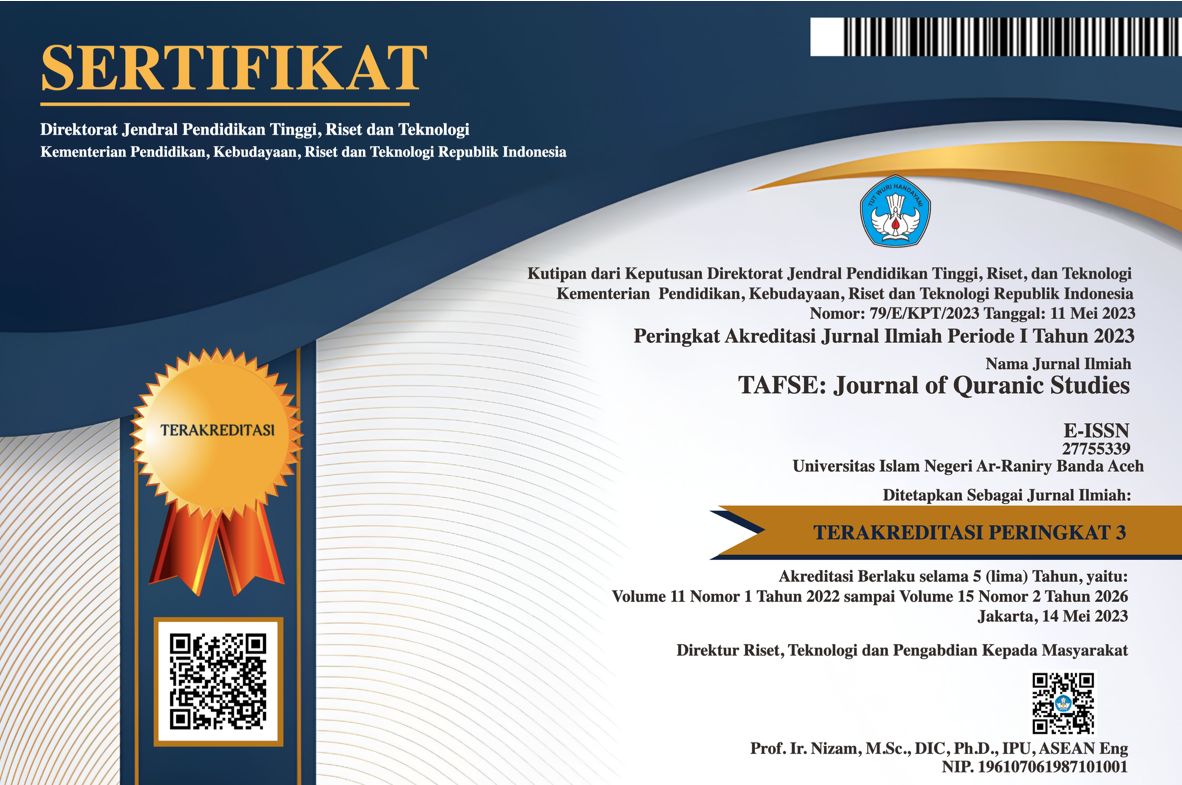Lafaz Mathar dan Ghaits dalam Al-Qur’an
DOI:
https://doi.org/10.22373/tafse.v4i1.13098Keywords:
Mathar, Ghaits, Muradif, Al-Qur’anAbstract
Some of the verses in the Qur'an have pronunciations that seem synonymous (muradif) but when examined further they have different connotations, such as in the words mathar and ghaits. There are various kinds of meanings of lafaz mathar and ghaits in the Qur'an, namely the amazing rain, the rain of stones, the rain of the sijjil, and so on. This paper aims to reveal how the meaning of the lafaz mathar and ghaits in the Qur'an is viewed from the muradif aspect and how the context of the use of this lafaz in the Qur'an is. This study is a literature review by collecting data and reviewing library materials consisting of primary and secondary data. The data obtained as documentation uses the maudhu'i method. The results of this study, the lafaz mathar is found in 9 surahs with 6 forms of lafaz variations, while the ghaits lafaz is found in 5 surahs and has 6 forms of lafaz variations. Lafaz mathar and ghaits have the same meaning, namely rain, but the context of the verse and the interpretation are different. Lafaz mathar shows more rain of doom, punishment, or reinforcements. While lafaz ghaits shows the rain of mercy or help from Allah.
Sebagian ayat-ayat dalam Alquran mempunyai lafaz yang tampaknya sinonim (muradif) namun bila diteliti lebih jauh memiliki konotasi yang berbeda, seperti pada lafaz mathar dan ghaits. Terdapat berbagai macam ragam makna lafaz mathar dan ghaits dalam Alquran yakni hujan yang mengagumkan, hujan batu, hujan sijjil, dan lain sebagainya. Tulisan ini bertujuan untuk mengungkapkan bagaimana pemaknaan lafaz mathar dan ghaits dalam Alquran ditinjau dari aspek muradif dan bagaimana konteks penggunaan lafaz tersebut dalam Alquran. Kajian ini adalah kajian kepustakaan dengan mengumpulkan data-data dan mengkaji bahan-bahan kepustakaan yang terdiri dari data primer dan sekunder. Adapun data yang diperoleh sebagai dokumentasi menggunakan metode maudhu’i. Hasil penelitian ini, lafaz mathar ditemukan dalam 9 surah dengan 6 bentuk variasi lafaz, sedangkan lafaz ghaits ditemukan dalam 5 surah serta memiliki 6 bentuk variasi lafaz. Lafaz mathar dan ghaits memiliki makna yang sama yaitu hujan, akan tetapi konteks ayat dan penafsirannya berbeda. Lafaz mathar lebih menunjukkan kepada hujan azab, hukuman, atau bala. Sedangkan lafaz ghaits menunjukkan kepada hujan rahmat atau pertolongan dari Allah.
Downloads
References
Ahmad Fuad Pasya. Dimensi Sains al-Qur’an. Solo: Tiga Serangkai, 2004.
Eny Yulianti, dkk. Kasih Sayang Allah dalam Air Hujan. Malang: UIN Malang Press, 2008
M. Quraish Shihab. Tafsir al-Mishbah. Jakarta: Lentera Hati, 2002
Muhammad Ali al-Sayis. Tafsir Ayat al-Ahkam, Jilid 2, Juz 3, Cet. I. Beirut: Dar al-Kutub al-Ilmiyyah, 1998.
Muhammad Fuad Abdul Baqy. Mu'jam al-Mufakras li al-Fadz al-Qur'an al-Karim. Beirut: Dar al-Fikr, l992.
Muhammad ibn Ahmad al-Anshari al-Qurtubi. al-Jami’ li Ahkam al-Qur’an, Juz 12. Kairo: al-Maktabah al-Taufiqiyah, t.th.
Nasruddin Baidan. Wawasan Baru Ilmu Tafsir. Yogyakarta: Pustaka Pelajar, 2016.
Quraish Shihab, M. Wawasan Al-Quran: Tafsir Maudhu‘i atas Pelbagai Persoalan Umat, Cet. 18. Bandung: Mizan, 2007.
Rasyid Rida, Muhammad. Tafsir al-Qur’an al-Hakim (Tafsir al-Manar), Cet. 2. t.tp.: Dar al-Fikr, t.th.
Sayyid Quthb. Tafsir Fi Zhilalil Quran. Jakarta: Gema Insani Press, 2002.
Downloads
Published
Issue
Section
License
Authors who publish with this journal agree to the following terms:
- Authors retain copyright and grant the journal right of first publication with the work simultaneously licensed under a Creative Commons Attribution License (CC BY NC 4.0) that allows others to share the work with an acknowledgment of the work's authorship and initial publication in this journal.
- Authors are able to enter into separate, additional contractual arrangements for the non-exclusive distribution of the journal's published version of the work (e.g., post it to an institutional repository or publish it in a book), with an acknowledgment of its initial publication in this journal.
- Authors are permitted and encouraged to post their work online (e.g., in institutional repositories or on their website) prior to and during the submission process, as it can lead to productive exchanges, as well as earlier and greater citation of published work (See The Effect of Open Access).





